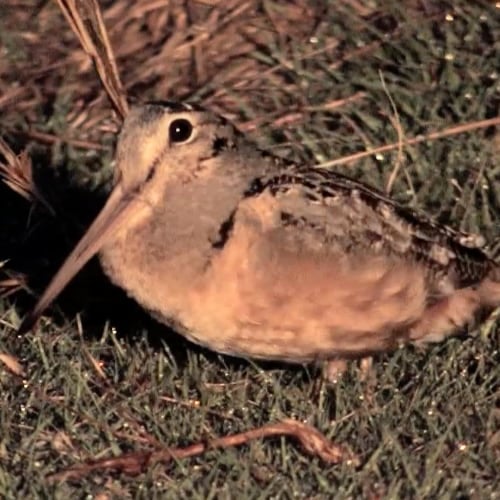
Drab, stout, short, and round, the Timberdoodle, a.k.a. the American Woodcock, doesn’t stand out in a crowd. At first.
With its oddly placed (as in on the top of the head) eyes and plumage mostly the shade of dead grass, the Timberdoodle can’t compete with the polka-dotted prettiness of the Sanderling, nor the lacework plumage of the Red Knot. And where the White-rumped Sandpiper looks red-carpet ready with his snowy breast, sable tailfeathers, and black-and-white clerical collar, the stubby-legged, rust-bellied Timberdoodle looks Artful Dodger back-alley shabby.
URI environmental scientists believe studying the bird may be the key to understanding the decline of certain bird and mammal populations in Rhode Island.
Specifically, the Timberdoodle may offer valuable insights into what constitutes a hospitable habitat for it and other species. URI researchers and graduate students aided by volunteers will take up the work of tracking the Timberdoodle again this spring to try to figure out the types of forest habitats that young forest species rely on. The Timberdoodle’s numbers have been in decline for more than 40 years.
Project Timberdoodle is managed by Erin Harrington, a Biological and Environmental Sciences Ph.D. student in the College of the Environment and Life Sciences. She is looking for 100 volunteers, “citizen scientists,” to monitor the birds in April and May. Volunteers attend a two-hour training session and then commit to four dates between April 20 and May 10, when, minutes after sunset, they will drive their designated survey route, stopping every quarter of a mile to listen and observe the birds for two minutes.
An avian with attitude
So how easy can it be to track a bird that so easily blends? Well, what he lacks for in looks, the male Timberdoodle makes up for in attitude, making him easy for the untrained bird watcher to recognize.
The male Timberdoodle has an easily recognizable mating call, the nasal peent, and performs an aerial display, called a sky dance, at dusk. Catch him dancing on the ground, and you’ll see he’s got moves. Project Timberdoodle affectionately calls him the Funky Timberdoodle.
“The male mating call is quite distinctive, and the aerial sky dance that it does to attract a female is distinctive as well,” Harrington said. “So even someone who doesn’t study birds for a living can pinpoint those and pretty definitively say, Yep, that was a timberdoodle.”
Research indicates that the decline of the Timberdoodle population is likely linked to loss of hospitable habitat, due to land development and aging forests. The birds and certain mammals require young forest, what you get after a fire or clear cutting of an area. “Project Timberdoodle, specifically, is about figuring out the types of young forests they prefer and likely need to survive. And then, hopefully, we can use that data to come up with a better-informed forest management plan for Rhode Island,” Harrington said.
“Can we manage forests to more closely resemble that habitat, make certain parts of forests younger, and help woodcock and other young forest species better survive?” Harrington asked. “Previous research has shown that if you create young forest for timberdoodles, other bird species and mammals that rely on young forest will benefit too.”
Enlisting the help of volunteers will enable Harrington and her team to get an entire census of the American Woodcock population in Rhode Island. Last year, URI’s Team Timberdoodle had 40 “citizen scientists.” Harrington is hoping to double that number this spring to survey the entire state.
—Marybeth Reilly-McGreen


